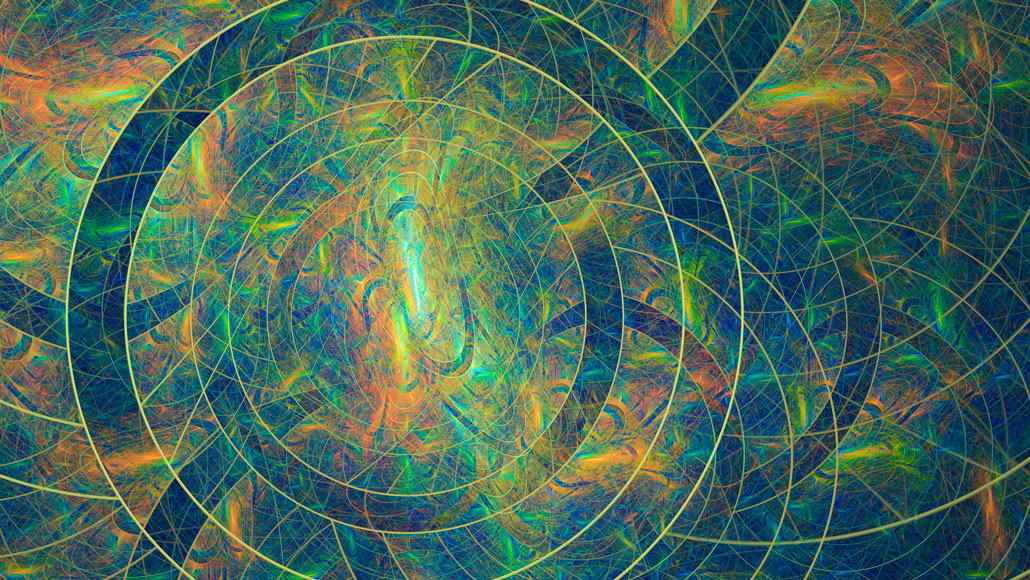Sean Carroll’s new book argues quantum physics leads to many worlds
Something Deeply Hidden contends that all possible outcomes of quantum experiments do come true

Some physicists believe that the math of quantum mechanics requires reality to consist of many coexisting worlds (illustrated conceptually here), a view defended by Sean Carroll in Something Deeply Hidden.
David Parker/Science Source
- More than 2 years ago
Something Deeply Hidden
Sean Carroll
Dutton, $29
Quantum physics is about multiplicity.
Its equations describe multiple possible outcomes for a measurement in the subatomic realm. Physicists have devised a dozen or two different interpretations of what that really means. And in turn, dozens and dozens of books have been written to explain, defend or deny the validity of those various interpretations.
Caltech physicist Sean Carroll’s Something Deeply Hidden defends one of the most provocative of those interpretations: that multiple possible measurement outcomes imply a multiplicity of universes. Known as the Many-Worlds Interpretation, that view contends that all the possible outcomes of quantum experiments actually come true.
Measuring the spin of an electron, for instance, might yield the result that the spin axis points either up or down. When the measurement is made, the universe splits, branching into two copies, one with the spin up, the other with the spin down. As each measurement is made, this view of quantum theory insists, additional universes are instantly created.
“The theory describes many copies of what we think of as ‘the universe,’ ” Carroll writes, “each slightly different, but each truly real in some sense.” If you want to know where these branches are, he says, “There is no ‘place’ where those branches are hiding; they simply exist simultaneously, along with our own, effectively out of contact with it.”
Many Worlds is a well-known quantum interpretation, originated in the 1950s by American physicist Hugh Everett III. It was mostly ignored for a long time. But in recent decades, many physicists have found it (or variants of it) preferable to the traditional view of quantum mechanics associated with Danish physicist Niels Bohr.
That standard approach is often glibly derided as “shut up and calculate,” since all the quantum math does is provide a recipe for calculating the likelihood of different experimental results. It doesn’t have anything to say about what unseen, or deeply hidden, mechanisms might be responsible for the recipe. And all competing interpretations, it seemed, predicted the same observable results.
But maybe not. Carroll argues that the various interpretations are actually “well-constructed scientific theories, with potentially different experimental ramifications.”
Carroll echoes Everett in contending that the key mathematical expression in quantum physics, known as the wave function, should be taken seriously. If the wave function contains multiple possible realities, then all those possibilities must actually exist. As Carroll argues, the wave function is “ontic” — a direct representation of reality — rather than “epistemic,” a merely useful measure of our knowledge about reality for use in calculating experimental expectations. In epistemic interpretations, “the wave function isn’t a physical thing at all, but simply a way of characterizing what we know about reality.”
In the ontic view, favored by Carroll, reality as a whole is one comprehensive universal wave function. We split up into copies of ourselves as we travel along the branching paths of events that the wave function encompasses. Or, as Carroll suggests, you can think of the process “as dividing the existing universe into almost identical slices.”
As quantum books go, Carroll’s is exceptionally clear, conversational and enjoyable. He has a knack for linguistic lubrication that helps make some highly technical concepts reasonably smooth to swallow. His is by far the most articulate and cogent defense of the Many-Worlds view in book-length depth with a close connection to the latest ongoing research (in the arena known as quantum foundations).
There are some minor shortcomings. Carroll’s historical passages are sketchy and sometimes misleading. The atoms proposed by Greek philosophers were not pointlike, as Carroll writes — they had size and shape and possibly even parts. And the last major salvo of Bohr’s quantum debate with Albert Einstein was not papers on quantum entanglement in 1935, but Bohr’s 1949 essay on the debate in a collection of papers about Einstein, and Einstein’s reply.
Toward the end of the book, the clarity of Carroll’s narrative diminishes somewhat — no doubt, as he acknowledges, because he has passed from the realm of established physics to the current unsettled search for the correct theory combining quantum physics with gravity. From that search, recent work indicates, an understanding of the quantum origins of space and time might emerge.
As for the many quantum worlds, Carroll’s case is strong but not conclusive. As he notes, a process known as quantum decoherence is “absolutely crucial to making sense” of the Many-Worlds view, explaining what happens when measurements select one possibility out of the wave function. In essence, decoherence occurs when microscopic quantum objects get entangled with the macroscopic environment, ensuring that only one result is observed by an experimenter on one branch. The other outcome occurs in another branch.
But other quantum experts use decoherence to explain quantum phenomena without invoking multiple universes. And as Carroll admits, the decoherence process does not require belief in the reality of the other branches. It just seems to him (and many others) to be the most elegant explanation for quantum mysteries.
So it remains the case that the ultimate definitive account of how to properly explain quantum mechanics remains unwritten. That secret remains hidden, if perhaps not quite as deeply as it once was.
Buy Something Deeply Hidden from Amazon.com. Science News is a participant in the Amazon Services LLC Associates Program. Please see our FAQ for more details.








